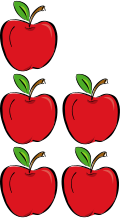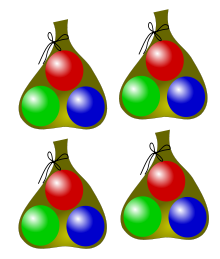ADDITION,SUBTRACTION,MULTIPLICATION,DIVISION
ADDITION,SUBTRACTION,MULTIPLICATION,DIVISION
Addition

Addition (usually signified by the plus symbol +) is one of the four basic operations of arithmetic, the other three being subtraction, multiplication and division. The addition of two whole numbers results in the total amount or sum of those values combined. The example in the adjacent image shows a combination of three apples and two apples, making a total of five apples. This observation is equivalent to the mathematical expression "3 + 2 = 5" (that is, "3 plus 2 is equal to 5").
Besides counting items, addition can also be defined and executed without referring to concrete objects, using abstractions called numbers instead, such as integers, real numbers and complex numbers. Addition belongs to arithmetic, a branch of mathematics. In algebra, another area of mathematics, addition can also be performed on abstract objects such as vectors, matrices, subspaces and subgroups.
Addition has several important properties. It is commutative, meaning that order does not matter, and it is associative, meaning that when one adds more than two numbers, the order in which addition is performed does not matter (see Summation). Repeated addition of 1 is the same as counting; addition of 0 does not change a number. Addition also obeys predictable rules concerning related operations such as subtraction and multiplication.

Performing addition is one of the simplest numerical tasks. Addition of very small numbers is accessible to toddlers; the most basic task, 1 + 1, can be performed by infants as young as five months, and even some members of other animal species. In primary education, students are taught to add numbers in the decimal system, starting with single digits and progressively tackling more difficult problems. Mechanical aids range from the ancient abacus to the modern computer, where research on the most efficient implementations of addition continues to this day.
| Arithmetic operations | ||||||||||||||||||||||||||||
| ||||||||||||||||||||||||||||
Subtraction
 Subtraction is an arithmetic operation that represents the operation of removing objects from a collection. Subtraction is signified by the minus sign, −. For example, in the adjacent picture, there are 5 − 2 peaches—meaning 5 peaches with 2 taken away, resulting in a total of 3 peaches. Therefore, the difference of 5 and 2 is 3; that is, 5 − 2 = 3. "5 − 2 = 3" (verbally, "five minus two equals three")
Subtraction is an arithmetic operation that represents the operation of removing objects from a collection. Subtraction is signified by the minus sign, −. For example, in the adjacent picture, there are 5 − 2 peaches—meaning 5 peaches with 2 taken away, resulting in a total of 3 peaches. Therefore, the difference of 5 and 2 is 3; that is, 5 − 2 = 3. "5 − 2 = 3" (verbally, "five minus two equals three")
While primarily associated with natural numbers in arithmetic, subtraction can also represent removing or decreasing physical and abstract quantities using different kinds of objects including negative numbers, fractions, irrational numbers, vectors, decimals, functions, and matrices.

Subtraction follows several important patterns. It is anticommutative, meaning that changing the order changes the sign of the answer. It is also not associative, meaning that when one subtracts more than two numbers, the order in which subtraction is performed matters. Because 0 is the additive identity, subtraction of it does not change a number. Subtraction also obeys predictable rules concerning related operations, such as addition and multiplication. All of these rules can be proven, starting with the subtraction of integers and generalizing up through the real numbers and beyond. General binary operations that follow these patterns are studied in abstract algebra.
Performing subtraction on natural numbers is one of the simplest numerical tasks. Subtraction of very small numbers is accessible to young children. In primary education for instance, students are taught to subtract numbers in the decimal system, starting with single digits and progressively tackling more difficult problems.
In advanced algebra and in computer algebra, an expression involving subtraction like A − B is generally treated as a shorthand notation for the addition A + (−B). Thus, A − B contains two terms, namely A and −B. This allows an easier use of associativity and commutativity.
Multiplication
Multiplication (often denoted by the cross symbol ×, by the mid-line dot operator ⋅, by juxtaposition, or, on computers, by an asterisk *) is one of the four elementary mathematical operations of arithmetic, with the other ones being addition, subtraction, and division. The result of a multiplication operation is called a product.
The multiplication of whole numbers may be thought of as a repeated addition; that is, the multiplication of two numbers is equivalent to adding as many copies of one of them, the multiplicand, as the quantity of the other one, the multiplier. Both numbers can be referred to as factors.
For example, 4 multiplied by 3, often written as and spoken as "3 times 4", can be calculated by adding 3 copies of 4 together:
Here, 3 (the multiplier) and 4 (the multiplicand) are the factors, and 12 is the product.
One of the main properties of multiplication is the commutative property, which states in this case that adding 3 copies of 4 gives the same result as adding 4 copies of 3:
Thus the designation of multiplier and multiplicand does not affect the result of the multiplication.
The multiplication of integers (including negative numbers), rational numbers (fractions) and real numbers is defined by a systematic generalization of this basic definition.
Multiplication can also be visualized as counting objects arranged in a rectangle (for whole numbers), or as finding the area of a rectangle whose sides have some given lengths. The area of a rectangle does not depend on which side is measured first—a consequence of the commutative property.
The product of two measurements is a new type of measurement. For example, multiplying the lengths of the two sides of a rectangle gives its area. Such products is the subject of dimensional analysis.
The inverse operation of multiplication is division. For example, since 4 multiplied by 3 equals 12, 12 divided by 3 equals 4. Indeed, multiplication by 3, followed by division by 3, yields the original number. The division of a number other than 0 by itself equals 1.
 Multiplication is also defined for other types of numbers, such as complex numbers, and more abstract constructs like matrices. For some of these more abstract constructs, the order in which the operands are multiplied together matters. A listing of the many different kinds of products used in mathematics is given in Product (mathematics).
Multiplication is also defined for other types of numbers, such as complex numbers, and more abstract constructs like matrices. For some of these more abstract constructs, the order in which the operands are multiplied together matters. A listing of the many different kinds of products used in mathematics is given in Product (mathematics). Four bags with three marbles per bag gives twelve marbles (4 × 3 = 12).
Four bags with three marbles per bag gives twelve marbles (4 × 3 = 12).
Division
Division is one of the four basic operations of arithmetic, the ways that numbers are combined to make new numbers. The other operations are addition, subtraction, and multiplication.
At an elementary level the division of two natural numbers is, among other possible interpretations, the process of calculating the number of times one number is contained within another. This number of times is not always an integer (a number that can be obtained using the other arithmetic operations on the natural numbers).
The division with remainder or Euclidean division of two natural numbers provides an integer quotient, which is the number of times the second number is completely contained in the first number, and a remainder, which is the part of the first number that remains, when in the course of computing the quotient, no further full chunk of the size of the second number can be allocated.
For division to always yield one number rather than a quotient plus a remainder, the natural numbers must be extended to rational numbers (the numbers that can be obtained by using arithmetic on natural numbers) or real numbers. In these enlarged number systems, division is the inverse operation to multiplication, that is a = c / b means a × b = c, as long as b is not zero. If b = 0, then this is a division by zero,which is not defined.

Both forms of division appear in various algebraic structures, different ways of defining mathematical structure. Those in which a Euclidean division (with remainder) is defined are called Euclidean domains and include polynomial rings in one indeterminate (which define multiplication and addition over single-variabled formulas).
Those in which a division (with a single result) by all nonzero elements is defined are called fields and division rings. In a ring the elements by which division is always possible are called the units (for example, 1 and −1 in the ring of integers). Another generalization of division to algebraic structures is the quotient group, in which the result of "division" is a group rather than a number.


















👍👍
ReplyDeletethnk u
Delete